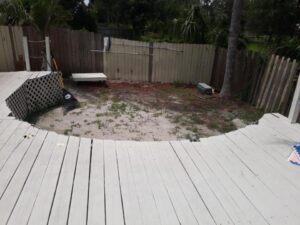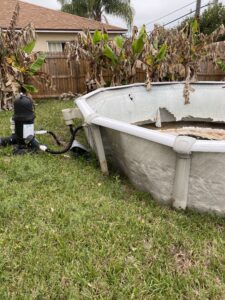Even though most who get an above-ground pool are thinking that they will only have it for a few years, many decide to keep them beyond the pool’s life AND wind up replacing it with a new one.
Every year in Orlando, I remove existing above-ground pools and replace them with brand-new ones. Often, they are replaced in the same place with the same size and shape.
WHEN IS IT TIME TO REPLACE YOUR ABOVE-GROUND POOL
Traditional above-ground swimming pools don’t last forever. Most will need replacing because the wall of the pool has become too rusty and is either in danger of blowing out (all of the pool’s water into the yard) or has already blown out.
For some others, the top rails have become rusty (if made of steel) or are cracking, discolored, sagging, or breaking (if made of resin). This has made the pool look bad and/or unpleasant to swim in.
In Orlando and surrounding towns, expect an above-ground pool to last between 10 and 20 years due to Central Florida’s harsh weather.
Other less common reasons to replace an AG pool are as follows:
A Big tree branches fell on them
B Tornadoes ( I replaced one that got sucked up into the sky in Deland during a tornado)
C Very poorly installed (They don’t last long when extremely off-level or out of shape)
D Pet horses rubbing against them (happened in Geneva once)
E Cows falling into them (happened in the Manor in St Cloud)
F Cars driving into them (Replaced for this reason in Kissimmee )
G Can’t get frame parts for the model anymore
H Neighbors accidentally shooting holes in them ( I’ve replaced several for this reason. Welcome to Florida)
REPLACING AN ABOVE-GROUND POOL WITH AN EXISTING DECK

In Orlando, having a deck along with an AG pool is very common. Here are some things you should know about replacing the old pool next to your deck with a new one.
1 The new pool very rarely will go back in the exact spot
Even though you are getting the same size pool, chances are that you won’t be able to get the new pool’s uprights exactly where the old ones were.
So, if the existing pool’s deck was built around the pool’s uprights, the new pool won’t fit perfectly to each cutout in the deck.
This is because every pool and model has slightly different dimensions AND each upright has a slightly different distance between them. So, if your deck is perfect to the existing pool, it won’t be perfect to the new pool.
2 In almost all cases, the deck was built AFTER the pool was installed.
Why does this matter? Because if your existing pool is out of round slightly AND/OR is not level, then the deck was built for a pool that is out of round and/or out of level.
Sooo, when the new pool goes in and the installer (like me) does a good job, the new pool will be level and in the correct shape (usually round). Soooo, if the existing deck is NOT quite level or built for a correctly shaped pool, then it will look and be off (not perfect).
3 Above ground pools come in three different heights – 48”, 52”, and 54”
Now why does THIS matter? Many decks are built to a specific height in relation to the height of the existing pool. So, if your new pool is a different height than the old one, then it will either sit higher (usually) or lower next to the deck than the old one did.
It’s common for people to want their new pool to be at the same level (in relation to the deck) as the old one was. If this is you, then my advice is to make sure your new pool is the same height as the old one.
This can be an issue if you have an older pool that is 48” tall. Most AG pools now are 52” and 54” high, so it can be hard to find a nice 48” walled pool anymore.
For most cases, if the new pool has a taller wall, then install the pool at the same level as the old one and just have a higher-looking pool sitting next to the deck. Unless your existing deck is sitting over the top rails that is.
4 Some decking may have to be cut to fit the new pool
During my years of martial arts training, I learned the 3 rules of fighting someone with a knife – Rule 1 “You’re gonna get cut”, Rule 2 “You’re gonna get cut”, and Rule 3 “You’re gonna get cut”.
After 38 years of replacing above-ground pools next to decks, I have one thing to say to the deck – “You’re gonna get cut”.
Yep, many decks have to get cut a little to make the new pool fit as close as possible. Try to accept this fact early on and you’ll be happier.
5 If needed, this is a great time to repair or replace the decking
REPLACING AN ABOVE-GROUND POOL THAT IS SEMI-INGROUND

Here in Orlando, sinking an above-ground pool partially in the ground is very common. AG pools in the ground some will last just as long as those above the ground, but some will need replacing.
It’s a little harder to replace an above-ground pool when its semi in the ground. You have to get in and out of that hole a lot and that takes extra energy. The biggest thing you should know though is this:
Replacing a semi-inground pool requires you to dig the hole bigger all the way around by AT LEAST eight inches. (For many, a foot wider or more is required)
It’s common to not think about the extra space it takes to assemble an above-ground pool. I mean, you can’t put the pool together somewhere else and helicopter it into place from the sky. LOL
Shaving the existing hole 8-12 inches bigger all the way around can be a bit of a job with things like roots from landscaping, decorative stones or mulch in the way, and/or weed-blocking materials. It can really be a party dealing with all of that stuff.
The good news here is that most of greater Orlando is sand-based, so shaving the hole should be easier than if it was hard earth.
And the dirt dug out to make the hole bigger will be in piles around the pool area, which can make a bit of a mess.
REPLACING AN OVAL ABOVE-GROUND POOL
The biggest thing to know here is that ovals have structures along their straight sides called buttresses. Every size and model can have a different number of buttresses AND they can sit in different spots within the pool’s footprint.
So, if you’re replacing an oval in a tight spot, you may not have the room for where the new pool’s buttresses will be protruding from the pool’s wall along the straight sides.
This can be an issue too if you have an existing deck. I often have to move either a couple of 4×4 wood deck supports OR shift where the new pool is going because the new buttresses are running into the existing deck supports.
